The type of material that a garden hose is made with greatly impacts its performance and functionality. If you have specific needs for your garden hose, you will want to make sure that the hose material you choose fits those needs. What is the best material for a garden hose?
The best hose material will depend on your specific needs. Rubber hoses are widely considered to be the most durable type of hose, and they are extremely flexible and easy to maneuver, but they are also prone to kinking. Rubber hoses are great for industrial applications or harsh environments.
Premium vinyl hoses use reinforced layers to prevent kinking, but that reinforcement makes the hose stiffer and harder to maneuver than a rubber hose. Then you also have metal, polymer, polyurethane, and nylon hoses that are built to be lightweight and easy to use, but may lack the durability and/or flow rate you need.
I personally like to use the Flexzilla hose, which uses a polymer blend. This hose finds a nice middle ground that pulls in several positives from the other types of hose materials. It is lightweight and easy to use, does a good job at resisting kinks, and also is quite durable.
If you want to read more about the Flexzilla hose (and see our testing photos), visit our article about the best 50 foot water hoses. The Flexzilla hose was the best overall hose we tested.
In this article let’s take a deeper dive into all of these specific types of materials, and I will use photos and videos of the hoses that I own so you can have a better idea what type of material might fit your needs. At the end of the article we will discuss specific needs you might have, and what material would best fit those needs.
Table of Contents
What Is the Best Material for a Garden Hose?
As we talked about above, the best material for a garden hose will depend on your specific situation. Do you need something that is durable that can handle the elements? If so, rubber is probably best. Do you want something ultra lightweight to water flowers with? Then a nylon expandable hose might be best.
Let’s take a closer look at the different types of hose materials, and discuss some of the advantages and disadvantages so you can find the hose material that matches your needs.
Types of Garden Hose Materials
Vinyl
Vinyl hose material can be both good and bad. Cheap hoses are made of vinyl, and will kink frequently. But there are also premium vinyl hoses that use extra layering to reinforce the hose, and help it maintain shape.
These premium vinyl hoses, in my experience, are the most kink-resistant hoses on the market. But it comes at a cost. These premium vinyl hoses are stiff, and not as easy to maneuver as a rubber hose.
For example, here is a vinyl hose that I own. Not only has this company used extra layering, but there is also a braiding throughout the hose to help it maintain its shape. If you look closely, you can see the braiding in the hose:
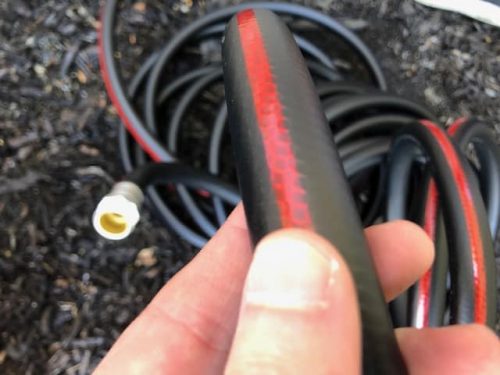
These premium vinyl hoses are very good at maintaining their form and shape. In fact, they’re almost too good at it. The hoses can be stiff and hard to maneuver around a yard (compared to a rubber hose). For example, here I am straightening out a premium vinyl hose that I own:
You’ll notice that even when it starts to tangle, the hose adjusts itself and resists kinking due to this reinforced layering. But you’ll also notice that it doesn’t straighten completely out. This isn’t a hose that you can easily whip around a yard.
But these types of premium vinyl hoses are very durable and very kink resistant. If you are someone who prioritizes kink-resistance, this may be your best option.
Rubber
Rubber is often considered to be the best hose material. And for many situations, that is true. Rubber hoses are very durable and very flexible, and can remain flexible even in colder winter temperatures. But because they are so flexible, they are also prone to kinking.
Although some may be marketed as being “kink resistant”, in general, they don’t have the same kink-resistant properties that premium vinyl hoses have. For example, here’s what happened when I straightened out a rubber hose last week:
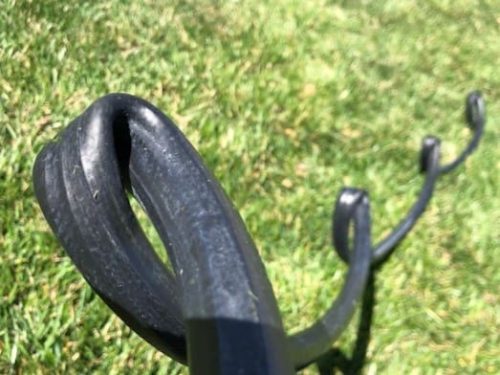
You often find advice from “experts” claiming that rubber hoses are kink-resistant. This is just not true. Yes, rubber hoses are great. They are durable, easy to maneuver, and can last a long time – but they will kink.
For illustration, in the video below, I straighten out a rubber hose that I just pulled out of the garage. Notice how easily it straightens (not stiff), but yes, does form some kinks also:
Although the rubber hose above kinked, the material is much more responsive to user control. Because the rubber material isn’t designed to hold a specific shape, it will respond much better when you swing it around in the yard or maneuver it around your garden.
Polypropylene
Polypropylene is a lightweight material that is often used in hoses designed for ease-of-use. For example, maybe you are looking for a lightweight, super-flexible hose to use for a small garden in your backyard.
Again, the problem here is a company can’t use extra layering to make the hose kink-resistant, because that in turn would cause the hose to weigh more and lose its flexibility (defeating the purpose). In this case, a hose company may use a wrapping along the hose to help it hold shape.
For example, here is a polypropylene hose that I own. As you can see, it has a blue coiling that wraps the outside of the hose and helps hold the hose’s shape and structure to prevent kinking.
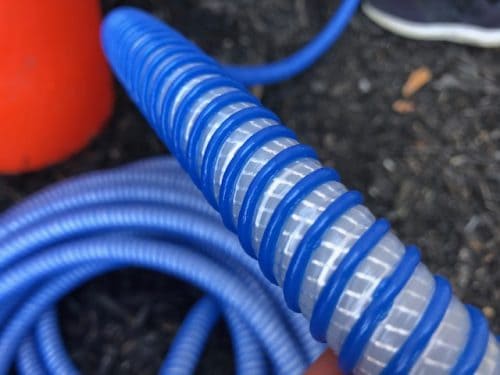
This hose is super lightweight, and very flexible, but still resists kinking. Here I am straightening out this polypropylene hose:
As you can see, every time the hose started to bend and potentially kink, the coiling snapped it back straight and prevented the kink. Now, to be clear, polypropylene itself is very lightweight, and not all poly hoses will resist kinking. But this hose, because of that coil wrap, does.
The downside to this type of hose is durability. A lightweight polypropylene won’t last as long as a commercial-grade rubber hose, and won’t be able to take a beating along the way.
Metal
Yikes, a metal hose? Yeah, that’s what I thought too when I first tried them. I was *shocked* at how easy they were to use, and how much I liked them.
The strength of a metal hose is they are (for the most part) pet-proof and chew resistant. If you have a dog that likes to chew on everything, these metal hoses can solve your problem.
But the benefits don’t just stop there. Metal hoses are very kink-resistant, and in my experience, basically impossible to kink. For example, here I am straightening out my favorite metal hose:
These hoses are very lightweight and very easy to maneuver. Here is a close-up look at the stainless steel material that is designed not to get hot in the sun:
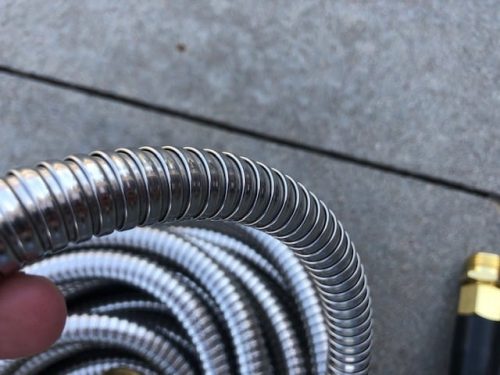
These are another great option if you hate kinking. But here’s where I would caution you: these hoses have a smaller diameter than standard garden hoses, which means the flow rate overall will be worse. If you rely on efficiency, I would stick with vinyl or rubber hoses.
I think the thing that shocked me the most about metal hoses was just how easy they were to maneuver. Hearing “metal garden hose” made me envision something stiff, but these metal hoses are actually very flexible and easy to operate.
Nylon
Nylon is the material used in most expandable hoses (also called pocket hoses). Some expandable hoses may use polyester, and will have basically the same results as nylon.
An expandable hose is sort of a gimmick, but it does serve a purpose. These hoses are ultra-lightweight (like, much lighter in weight than a normal hose), and are easy to store. These hoses are practically kink proof.
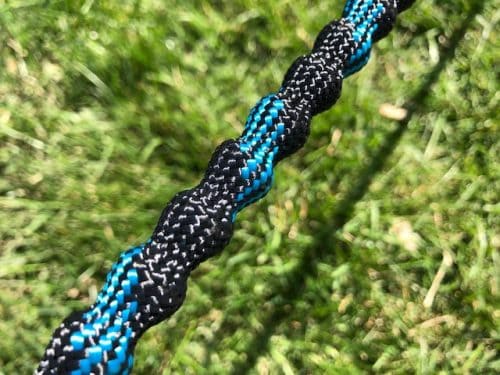
The material is designed to stretch and retract as you move, much like a rubber band would. This design basically eliminates the chances of kinks.
But you’ll want to be careful when you use an exandable hose. If you stretch it to the max, and let go, it could knock out a window if you’re not careful:
What’s the drawback? These hoses are not as durable as rubber and premium vinyl hoses, and they have a smaller diameter, leading to a worse flow rate and less efficiency. These hoses are best for small tasks, like watering flowers near the spigot.
Other Polymer Blends
Some hose companies don’t disclose (for competitive reasons) the material they use to make their garden hose. As I mentioned at the top, I like the Flexzilla hoses that use a polymer blend to make a garden hose that is reasonably lightweight, flexible, and durable. I feel like this Flexzilla polymer blend is a great middle-ground, and an all-around great hose material.
Here’s what it looks like:
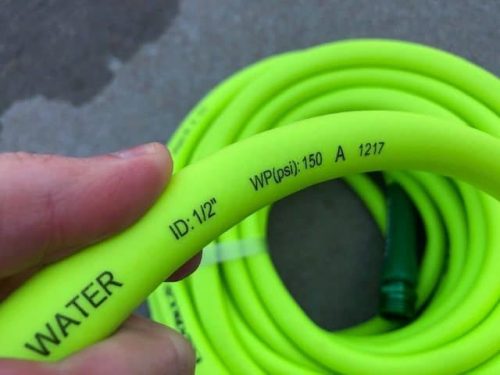
It is very easy to handle and isn’t a stiff material. Here I am straightening out a Flexzilla hose:
Overall, when we tested the Flexzilla hoses we found them to be quality hoses that had great flow rates and passed our crush resistance testing. This is a great option if you are looking for an easy-to-use, dependable hose for around the yard.
Best Hose Materials for Specific Needs
What is the best hose material if you want a lightweight hose?
Nylon expandable hoses will be the most lightweight option you will have, but please understand that those hoses won’t make sense for all situations. As we discussed earlier, expandable hoses are great for small tasks near the spigot like watering flowers or a small garden.
Polypropylene is another lightweight material which might be a good option. The only drawback to polypropylene is it isn’t as durable as rubber or premium vinyl, and will need to be cared for accordingly.
If you want a lightweight garden hose that feels and functions like a normal hose, I’d recommend buying a Flexzilla hose that uses a polymer blend to create a hose that is lightweight compared to premium vinyl and rubber hoses, but has the flow rate and durability you’d expect from a premium hose.
What is the best hose material if you want a durable hose?
Rubber is likely your best option here, but premium vinyl hoses are also very durable. Some premium vinyl hoses have multiple layers of reinforcement and can be just as durable as rubber.
Metal hoses are also very durable and can be a nice solution if you have a dog that likes to chew on a hose.
What is the best hose material if you want a flexible hose?
Rubber will be your best option if you want a flexible, easy-to-maneuver garden hose. Lightweight polypropylene hoses are another good option, but they won’t be as durable as rubber.
There are other polymer blends that can be flexible as well. Metal hoses are surprisingly easy to maneuver and very flexible also.
What is the best hose material if you want a hose that won’t kink?
Premium vinyl hoses, in my experience, are the best hoses are resisting kinks. Please understand that I am talking about premium vinyl options that use multiple layers of reinforcement to add form and structure to the hose. Cheap vinyl hoses will not be kink-resistant.
Metal hoses are practically kink-resistant, but in my experience they have worse flow rate than typical garden hoses, so I would personally stick with a premium vinyl hose. If you want to do a deeper dive into what hose materials kink, read more here.
What is the best all-around hose material?
This is a tough question to answer without knowing your specific needs. I personally like to use the Flexzilla hose, which uses a polymer blend, because I feel like it is the best all-around performing hose material that I have found.
If you prioritize flexibility and durability, rubber will be a great choice for you. If you hate fighting kinks, then premium vinyl hoses might be your best option. If you are looking for something easy and lightweight for flowers, then a nylon expandable hose is a nice choice.
